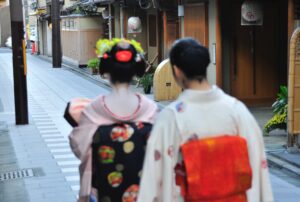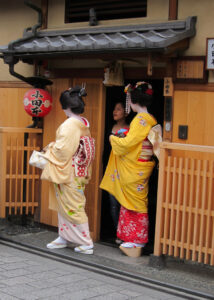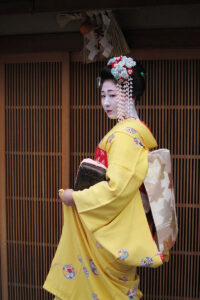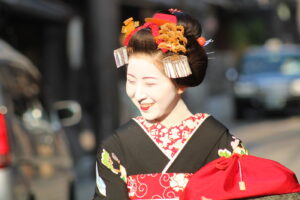Chapter scope: This chapter introduces how one becomes a maiko (apprentice geisha) and a geiko (as Kyoto geisha are known) in Kyoto’s hanamachi (districts where maiko and geiko work). We learn about the training, skills, and responsibilities associated with each stage. We see how contemporary Japanese experts praise the transformation of the “ordinary girl” into the maiko-like maiko and fully-fledged geiko. Experts’ books emphasize decorum, femininity, and “learning through the body” in “on the job training.” They celebrate the hanamachi for preserving older forms of Japanese etiquette.
Discussion Activity for Small Groups/Class
Discussion can lead from understanding the key points of this chapter to broader conversations on etiquette, expectations for gender-role performance in the workplace, and even satire. Here’s one idea for extending the conversation.
In class discussion, students suggest careers in Japan or another country that require the polished performance of etiquette on the job. Divide into groups, each group choosing one career to discuss in more detail:
- What kinds of behaviors does the role require? (Speech? Uniform? Body movement?)
- Who is the employer and who is recipient of this performance?
- Hint: If you need examples, try searching for online articles for videos on Dos & Don’ts for Job Interviews.
- Share your group’s thoughts with the class.
RETURN TO WHOLE CLASS DISCUSSION - Considering all examples suggested, what do you see emerging as the broad goals for on-the-job etiquette?
- Are these performances associated with age, gender, physical ability, national or regional identity, or other categories?
- How would you assess the pros and cons of on-the-job etiquette performance?
- What etiquette skills do you think might be required to perform in the kinds of career paths that interest you?
Short Writing Exercises:
Ad for prospective maiko: Imagine that you are writing a short article (250 words) for a local Japanese newspaper encouraging girls to consider applying to become shikomi trainee. Use evidence from Ch. 3 to describe the training, the living situation, and the expectations.
Reflect on training philosophy: “Form sustains spirit. Spirit sustains form. I sense that is what constitutes cultivation (shugyō) in the hanamachi (64).” What does Aihara mean by this comment? Give an example of how some aspect of maiko training exemplifies this philosophy. (150 words).
News report: Imagine you are reporting on the misedashi debut of a new maiko for your hometown newspaper (250 words). Describe the maiko’s look, what happens in the scene, its significance to the hanamachi. To do this exercise, find an online video of a misedashi. Try using the characters for maiko-san misedashi 舞妓さん店出し. Here is one uploaded to YouTube by Anna Film Productions on Dec. 9, 2019 https://www.youtube.com/watch?v=klM3kHmJwbE
Schedule a maiko’s week: Imagine a week in a busy, successful maiko’s life, full of routine day and evening activities, but some special events, too. Write the activities for a week in her planner (150 words).
Interview a new geiko: Imagine that you have the chance to interview a geiko, newly independent and moving into her own home. Imagine how she describes her new situation, responsibilities, and freedoms. (150-200 words). Use details from Ch. 3.
Reading Questions: Keep these questions in mind as you read the chapter and organize your thoughts.
Chapter Introduction
- What sources inform this chapter?
- What is the main argument proposed?
- How does hanamachi training compare to some other forms of etiquette for women in Japan or your country–in homes, schools, and corporations?
- What are the philosophical codes underpinning hanamachi etiquette training? How have these changed over time?
The Shikomi Trainee
The prospective maiko has serious training ahead before she ever wears the maiko’s formal costume.
- What kind of training and living space is an okiya? Who runs it and who lives and works there?
- What do okiya mothers expect the shikomi to learn? What do the mothers see as the main difficulties in training shikomi?
- What are kata and how do shikomi learn them?
The Minarai Period and the Misedashi Debut
Minarai maiko: Katsunosuke of Odamoto okiya (Gion Kôbu). 2011. Photo: lightstars posted to Flickr. Wikimedia Commons
- Describe where minarai training takes place and what is involved.
The Misedashi Debut
- How does Komomo, the maiko featured in A Geisha’s Journey and cited in Ch. 3, experience her shikomi and minarai training, and her misedashi?
- Maiko experience the misedashi as an exciting, nerve-wracking blur of excitement. How does what you read about the event in Ch. 3 compare to videos online of misedashi (see writing exercise News Report above)?
Working as a Maiko
What do clients and hanamachi elders expect of maiko?
“The maiko becomes the perfect daughter (74).” What does this performance of daughterhood entail? How does this help define maiko-likeness?
Turning the Collar to become a Geiko
- Not all maiko become geiko. What do you see as the pros and cons of continuing on the career path? What does her profession entail?
- How do the geiko cited in Ch. 3 describe the transition from maiko to geiko and the shift in expectations for them?
- Some maiko become jikata. What does this position involve? Who may apply to become a jikata?
- Why are geisha sometimes viewed with suspicion in Japan, given that “geisha are often cast as the epitome of woman on her best, most feminine Japanese behavior (80)?” This quote comes scholar Kelly Foreman’s essay, “The Perfect Woman.” (full citation in Suggested Readings below)
Wrap-up of Chapter Analysis
- How did Ch. 3, “The Well-Mannered Career Path” add to your knowledge of the hanamachi, Japanese forms of etiquette, and etiquette more broadly?
- What did you find missing in the chapter? What would you like to know more about?
Satire: Turning the Tables on Etiquette
The rules of decorum are always ripe for satire. Consider how these comic Japanese examples push back at the constraints for mannerly performance. What makes them funny? What messages are they communicating?
“The Japanese Tradition: Bowing” by the comic duo Rahmens
“The French Restaurant Scene,” in Tampopo, 1986 Japanese comedy directed by Itami Jūzō. Observe the setting, the seating of hosts and clients, the French menu, and the way the most junior person present places his order.
Suggestions for Further Reading
Cynthia Dickel Dunn. “Bowing Incorrectly: Aesthetic Labor and Expert Knowledge in Japanese Business Etiquette Training.” In Japanese at Work: Politeness, Power, and Personae in Japanese Workplace Discourse, edited by Haruko Minegishi Cook and Janet S. Shibamoto-Smith, 15–36. New York: Palgrave Macmillan, 2018.
Kelly Foreman. “The Perfect Woman: Geisha, Etiquette, and the World of Japanese Traditional Arts.” In Manners and Mischief: Gender, Power, and Etiquette in Japan, edited by Jan Bardsley and Laura Miller, 67–79. Berkeley: University of California Press, 2011.
Komomo and Naoyuki Ogino. A Geisha’s Journey: My Life as a Kyoto Apprentice. Translated by Gearoid Reidy and Philip Price. Tokyo: Kodansha International, 2008.




